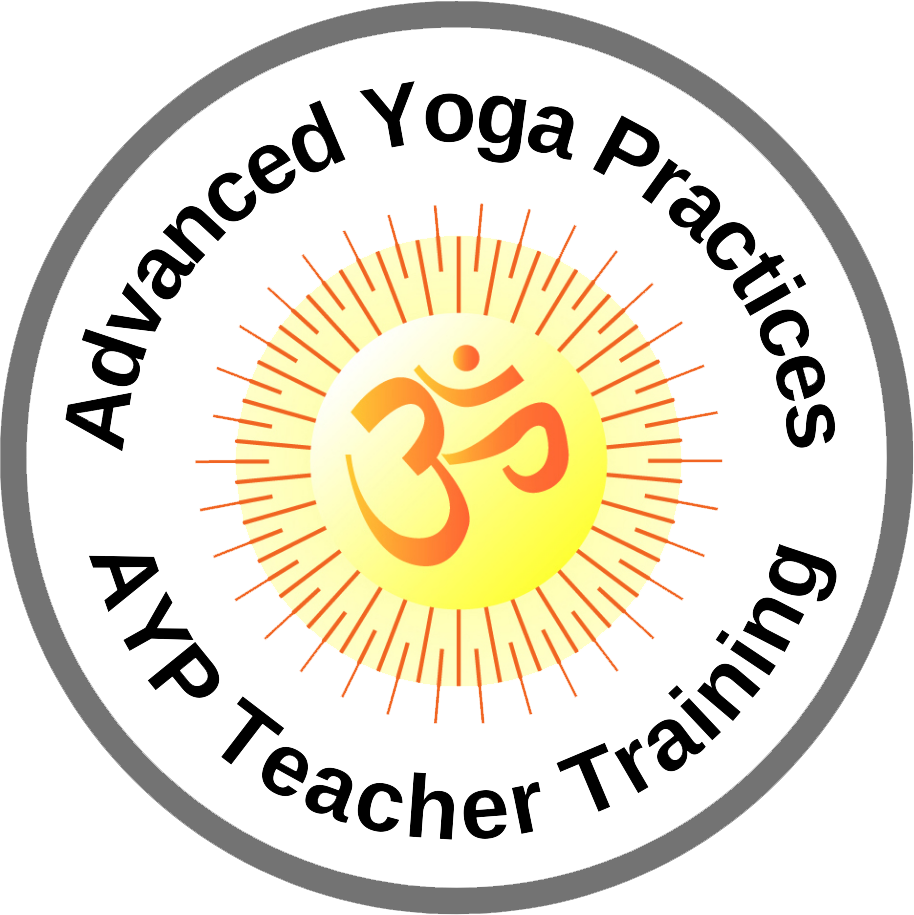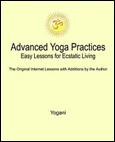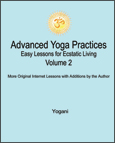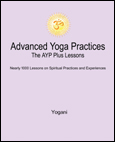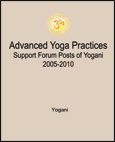|
Public Home | Plus Home | Main Lessons | Tantra Lessons | Public Forum | Plus Forum | Downloads | Books Topic Paths | Search | Training-Retreats | Testimonials | Survey | Interviews | MultiMedia | Contact | Donate |
|
Advanced Yoga Practices Note: For the Original Internet Lessons with additions, see the AYP Easy Lessons Books. For the Expanded and Interactive Internet Lessons, AYP Online Books, Audiobooks and more, see AYP Plus. Lesson 365 - The Range of Sensitivities to Deep Meditation (Audio)
AYP Plus Additions:
From: Yogani New Visitors: It is recommended you read from the beginning of the web archive, as previous lessons are prerequisite to this one. The first lesson is, "Why This Discussion?"
Everyone is a little different in how they may respond to spiritual practices, and particularly to deep meditation with mantra. It is a powerful technique. How it functions in each person will depend on the unique matrix of obstructions combined with openings already present in the individual nervous system. It is not possible to fully predict what these may be in each person, but we can see that the response to deep meditation will have its own signature for the practitioner. By observing the range of responses in many practitioners, we can see that there is clearly a range of sensitivities to deep meditation, and to other spiritual techniques as well. In AYP we have had the opportunity to observe the many responses to deep meditation closely over the years, as experiences have been reported in private emails and in the public AYP Support Forums. What we have seen is a range of sensitivities. In spite of our natural desire to find the one size that fits all, it is not so any more than for other things in life. The span of individual sensitivities in the community of practitioners is quite wide, covering a full range from under-sensitive to over-sensitive. An important challenge we have faced in AYP is the same as with many things that are offered to the public how to provide focused means for accomplishing a specific task that will serve most people, while at the same time accommodating a broad range of user/practitioner sensitivities to the means applied. Of course, in this case, the specific task is the cultivation of abiding inner silence. We are not talking only about personal preferences. We are talking first about the results experienced from deep meditation practice over the short term and the long term. The results then affect personal preference, and this is an important consideration also. If deep meditation is not producing the desired results, or is excessively uncomfortable, then this will adversely affect ones desire to practice at all. Fortunately, the large majority of practitioners fall in the center of the range of sensitivity, where most variations in experience can be easily managed with the methods of self-pacing and grounding we have discussed throughout the lessons. On either side of the large center group of practitioners we have those who may be either under-sensitive or over-sensitive to deep meditation. While scientific investigation of sensitivities to deep meditation is yet to occur, at this time we can see that the distribution of sensitivities resembles a bell curve, where the few highly under-sensitive meditators would be on the far left of center, the few highly over-sensitive meditators would be on the far right of center, and the majority of practitioners who are neither under nor over-sensitive occupying the center. Using the image of a bell curve, we can see that most practitioners are in the center range of stability, manageable with the standard means of self-pacing and grounding. As we go out to either side of the center, we find the fewer practitioners who are either under-sensitive or over-sensitive. It is these practitioners who require additional understanding and assistance with means to compensate in ways that will facilitate good progress with comfort and safety in deep meditation. We will see in upcoming lessons that both ends of the scale of sensitivity to deep meditation have gifts that are uniquely their own. No one is at a particular disadvantage. Only a clearer understanding of the dynamics of transcending objects of awareness in meditation is necessary. It is a matter of making sure that everyone has the tools that they need. Under-Sensitive to Deep Meditation While most practitioners of deep meditation notice something happening in their daily life to indicate some inner silence is coming up, not everyone does. In some cases, the meditator might not notice results for a long time, even if others in close proximity do. The practitioner may say, "Nothing is happening." Whether nothing is happening or not will depend on a number of factors, including the degree to which the finer points of the procedure of deep meditation are being utilized, the extent to which subtle results can be noticed, the role of practitioner expectations, and so on. It is extremely rare that nothing will be happening. It is a matter of understanding the process and applying particular means for insuring that practice is correct. Sometimes it is simply a matter of improving feedback on results, and adjusting our expectations. It is also a matter of bhakti (spiritual desire) and keeping up daily practice over the long term. Regardless of our sensitivity, or lack of it, the key to success in deep meditation is in long term twice-daily practice. So, while under-sensitivity to deep meditation may seem to be the primary issue, it really isn't. The issue is our commitment to daily practice over the long term, for as long as it takes. If we can sustain that, the results will be there. In fact, with the way things are going in the world, we may find ourselves shifting to the center of the bell curve sooner rather than later. And if we are too aggressive in our practice, we could slip all the way over to being over-sensitive! It can happen. So self-pacing is for everyone, even those who believe they are under-sensitive. It can change in a heartbeat. We will take a closer look at under-sensitivity to deep meditation, and measures that can be taken, in the next lesson. Over-Sensitive to Deep Meditation Whenever we have a feeling of overdoing, particularly after we get up from our meditation session, it may simply be that we need to take more rest before we get up, or adjust our meditation time a bit lower, or be more involved in daily activity to stabilize the results of our practice. After making sure we are taking the normal measures, if we are still finding irritability during the day, or other uncomfortable symptoms, then we may be over-sensitive. This may lead us to self-pace our practice time to only a few minutes per session, with similar reductions in other practices we may be doing during our sittings. Those who find themselves to be over-sensitive to deep meditation often have high bhakti (spiritual desire), so it can be frustrating to be limiting practice to such a degree. Yet, it happens, and we have to honor our psychological and physical well-being. That is what self-pacing and grounding are for. Over-sensitivity in a few meditators is something we have been working on since the early days of AYP (see Lessons 160 and 200). It has been a gradual evolution, with ongoing discussions and research, and still much more to be done in this area. Beyond standard self-pacing and grounding, there are some alternatives for over-sensitive meditators, some ways to lengthen our meditation sittings while minimizing symptoms of over-doing. We will review them a few lessons down the road. These solutions are tentative, still in testing. No one solution may work for all over-sensitive meditators. So we are approaching this carefully, in a way that can offer some assistance without muddying the waters unnecessarily for anyone. In the meantime, it is suggested to continue self-pacing as necessary to keep things on an even keel, no matter where you find yourself on the sensitivity scale. Increasing Spiritual Sensitivity Worldwide While it cannot be stated as scientific fact, it is obvious to many that there is an underlying factor contributing to increasing sensitivity in everyone to deep meditation and all spiritual practices. For some time, many have perceived that world consciousness is on the rise, and accelerating (see Lesson 93). With rising world consciousness, a natural sensitivity is rising in everyone, and along with it a sensitivity to spiritual practices. What does this mean? It is good news. The contributions of millions of spiritual practitioners worldwide since the middle of the 20th century have created a momentum of rising inner silence in the world that is palpable, and which makes embarking on an accelerated program of spiritual progress much more fruitful than it used to be. The claims of a "new age" are not unfounded. What this means in terms of the distribution of sensitivities to deep meditation, and all spiritual practices, is that the bell curve covering all practitioners of deep meditation is gradually shifting (becoming skewed) to the right. All practitioners are becoming more sensitive. It means we are all traveling faster on our spiritual path. It also means that we must be mindful to be self-pacing our practice as needed and keeping active (grounding) during the day. As we continue on our path of practices over time, we may find that less practice is more. Many have been experiencing this already, and there are good reasons to believe that the trend will continue in that direction. The number of spiritual practitioners in the world is increasing rapidly. The ongoing result of this is an increasing rate of the rise in world consciousness. The implications of this are far-reaching. In the meantime, the change in world consciousness is necessitating a shift in the application of spiritual practices to support stable progress. In AYP we are seeing it in individuals who have become more sensitive to practices, and in the community as a whole. So there are practical issues relating to practices that will have to be resolved as we continue to move forward. Because AYP is an open resource, everyone is free to take on practices and make adjustments as necessary according to individual experiences and needs. This kind of self-directed approach is essential in these times of changing spiritual sensitivity. The elements of self-pacing, grounding, additional kundalini measures, and alternative modes of practice are all part of the tool kit we'd like to have available for anyone who wishes to build an effective spiritual practice routine. The guru is in you. Discuss this Lesson in the AYP Plus Support Forum Note: For detailed instructions on deep meditation procedure, see the Deep Meditation book. For detailed instructions on building a balanced practice routine with self-pacing, see the Eight Limbs of Yoga book. Also see AYP Plus. |
|
|







